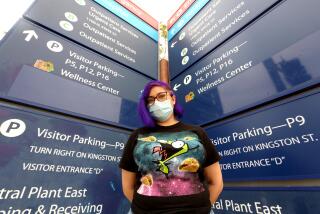Mental Health Aides Fight to Help Those in Greatest Peril
- Share via
It was only 8 a.m. and Bill Peck was already sweating. He had just dialed the home phone number of a woman he had hoped to check into a psychiatric ward by nightfall.
“No one is answering. That’s not a good sign,” said the Los Angeles County social worker.
In a previous visit, Peck had noticed that the young woman had begun chattering about the devil again. She was incontinent. Both were ominous signs for a woman with a history of trying to hurt herself with hot water, cigarette lighters and stove burners.
By nightfall, Peck had located and counseled her. But in between there were other mentally ill clients that day needing his attention: the delusional man in love with singer Joni Mitchell, a volatile young mother whose baby had been taken away, among them.
They are among the San Fernando Valley’s most severely mentally ill. But the county is providing a new way of helping them lead their lives as independently as possible.
A year ago, the county’s Department of Mental Health kicked off a pilot project in the Valley to identify and give extra attention to the heaviest users of its services. Four veteran mental health workers crisscross the Valley most days to visit with 80 or so clients in the program.
The intensive case management program, as it is called, is the first of its kind in Southern California. For county officials, it serves a dual purpose. Officials hope that the added investment in this select group of the neediest mentally ill not only will improve their lives but will save money and hospital bed space.
The experiment so far has lived up to expectations, county administrators said in recent interviews.
“The whole idea of the program is to see if there isn’t a better way to serve this population. It seems it is certainly working,” said Ken Miya, the program’s project director.
Hospitalization Figures
His yardstick is the latest set of figures on the number of days the program’s enrollees are spending in hospitals. Before the program’s start, 71 future participants had stayed a total of 4,383 days in county or state mental wards during the 1986-87 fiscal year. During the experiment’s first 10 months, however, the same group spent just 687 days in a hospital.
That decrease meant the county paid $120,000 for hospital stays during the program’s first 10 months, compared to $635,000 paid for hospitalization during the 1986-87 fiscal year, Miya said.
Several of the clients said during recent interviews that they are deeply appreciative of the extra attention the program’s social workers provide.
County Prototype
The experiment has served as a prototype for the countywide mental health system. But with funds for the county’s mental health network evaporating, the program’s future remains clouded.
The fate of every program is “up in the air,” said Roberto Quiroz, the director of the county’s mental health department. But he said, “When the dust clears, I think case management with the focus on the severely chronically mentally ill is the way we’ve got to go.”
The experiment began when a county computer was enlisted to identify the Valley’s most dependent mentally ill clients. The criterion: those who had generated the biggest mental-health care bills in 1986-87.
The computer extracted a pool of 1,530 from the Valley, Glendale and Eagle Rock who had used county mental health services the most. From that list, caseworkers started contacting the top 100 or so individuals to see if they would be interested in participating.
The typical participant is white, between ages 26 and 45, and living with family or in a residence. About half are males, half females.
A small, idealistic staff started what they call their “missionary work” last April. Since then, the county’s financial woes cut the program’s staff in half to four caseworkers. Later, the full-time psychiatrist was reassigned elsewhere three days a week. After that happened late last year, the clients’ rate of hospitalizations in state institutions jumped almost 400% during a period of four months.
But despite the setbacks, the staff members said they remain committed to their clients, who oftentimes are estranged from family and friends whose patience dried up years ago.
Psychiatrist in Charge
The psychiatrist who takes care of the group’s medical needs is Dr. Paul Joseph, 35. The bearded phy The caseworkers have relied heavily upon Joseph to prescribe drugs because almost all their clients require medication.
Suzy entered the program with a set of prescriptions she had received at a hospital, but her behavior remained bizarre. Twenty times a day she was calling her caseworker, Sue Melton, telling her she was fired and then rehired.
Joseph was summoned, and he prescribed a better combination of medications. Suzy’s calls stopped, and he gradually weaned her off all medication. Today, Suzy is working at a yogurt shop and doing volunteer work.
The small staff meets frequently in their North Hollywood office, which is furnished with salvaged furniture and just two filing cabinets.
Some of caseworkers’ approaches seem surprisingly simple.
Vangie Montalvo, a bilingual caseworker, once resorted to an Old World “cure” to help one of her deeply troubled clients. The client, a 19-year-old woman who hears voices, would frighten her family by uncontrollably twisting her body in grotesque ways, Montalvo said.
The Latino family believed that the teen-ager was the victim of a curse placed by one of her mother’s co-workers. Montalvo’s suggestions for the daughter’s care were largely spurned.
Family Counseled
So Montalvo turned to a social worker at Metropolitan State Hospital in Norwalk who works with the superstitions of recent immigrants. He counseled the family using mainstream therapy methods, but also performed an exorcism, which seemed to improve the girl’s condition, if only slightly.
More to Read
Sign up for Essential California
The most important California stories and recommendations in your inbox every morning.
You may occasionally receive promotional content from the Los Angeles Times.













